Range Rover Evoque: Component Description
ATC MODULE
NOTE: The 'ECON' button has been renamed 'A/C' to prevent confusion with the Stop/Start system 'Eco' switch.
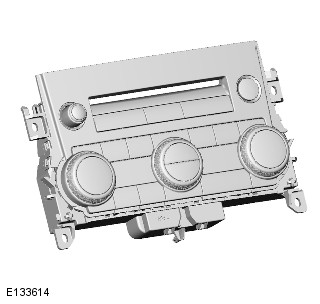
The ATC module is mounted in the center console and is integral with the control panel. The module works in conjunction with the ECM to control all aspects of heating, ventilation, and A/C. An 18-pin electrical connector on the rear of the module provides hardwired, CAN bus and LIN bus connections to allow interaction with A/C system components and other vehicle control modules.
Six different ATC modules (2 single zones, 4 dual zones) are available, depending on vehicle specification. Low specification vehicles feature 3 rotary controllers and 3 top hinged momentary switches to control the quality, temperature and distribution of air into the cabin. High specification vehicles feature 3 rotary controllers, 6 top hinged momentary switches, and 2 dual function momentary switches to control the quality, temperature and distribution of air into the cabin.
In addition to the A/C system, the ATC module controls operation of:
- The seat heaters
- The rear window heater
- The windshield heater
- The exterior mirror heaters.
For more information, refer to the 'System Operation' section above.
A number of changes have been made to the logic and operation of climate control system, within a Stop/Start cycle to:
- maintain occupant comfort
- prevent windshield misting
- conserve battery power.
This has been achieved by the ATC module monitoring and varying, as necessary various climate control functions within a Stop/Start cycle.
In some circumstances the ATCA has the capability to inhibit an engine shutdown or initiate an engine restart within a Stop/Start cycle. This is achieved by the ATC module communicating with the CJB on the medium speed CAN. The various override functions the ATC has in a Stop/Start cycle are discussed below:
Coolant temperature
The ATC module will inhibit an engine shutdown or initiate an engine restart within a Stop/Start cycle if the coolant temperature falls below the calculated threshold to support the cabin temperature set by the vehicle occupants.
Windshield demisting
The variant of climate control fitted to the vehicle influences the software changes that have been made. For example, the base climate-control system does not have a humidity sensor, as used on a highline system to initiate a windshield demist. Therefore, a calculation for demisting the windshield is made using the signals from the rain sensor and ambient temperature sensor. Using the probability that windshield misting will occur if it is raining and the ambient temperature is cool, the ATC will presume a windshield demist is required and start the engine when in a Stop/Start cycle.
Evaporator temperature the main cause of windshield misting is also monitored and the high-line climate control system will periodically cool the evaporator as necessary to reduce misting during a Stop/Start cycle. The system operates the windshield demist shutter and if the evaporator is wet the shutter will remain closed for a few seconds after an engine restart until the vapor is dissipated.
If the driver selects either 'programmed defrost' or the 'windshield heater' it is assumed that a quick demist of the windshield is required. Therefore, the ATC via the CJB will either: inhibit an engine shutdown or initiate an engine restart.
Heater fan speed
During an engine shutdown the ATC monitors cabin temperature and maintains the fan speed at a level that will conserve, for as long as possible the heat in the core of the cabin heater. If the driver selects a higher fan speed and the heat cannot be maintained in the heater core, the engine will restart.
Heated rear window and heated seats
If the heated rear window or heated seats are active or activated during an engine shutdown event the power output of the relevant system will be interrupted until the engine is restarted. The tell-tale light in the relevant switch will illuminate to indicate the system is active even though the system is receiving no power. This feature is used to conserve battery power.
Fuel fired heater
The FFBH (fuel fired booster heater) and Stop/Start system will not operate simultaneously, due to low ambient temperatures being a factor in the function of both systems.
COMPRESSOR SOLENOID VALVE
GTDi
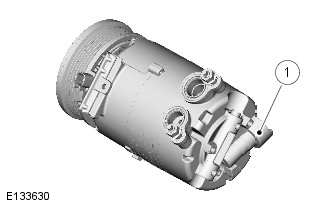
- Pressure control valve
DW12C
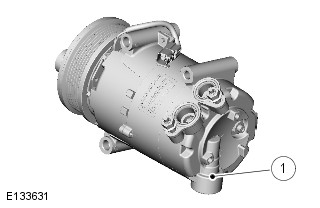
- Pressure control valve
The compressor pressure control valve is integral with the A/C compressor. The operation of the control valve is self contained. The pressure control valve controls the flow of refrigerant (displacement) through the compressor depending on the demand determined by the thermal expansion valve, effectively controlling the evaporator operating temperature and cabin humidity by varying the pressure within the A/C system. For additional information, refer to: (412-01 Climate Control)
REFRIGERANT PRESSURE SENSOR
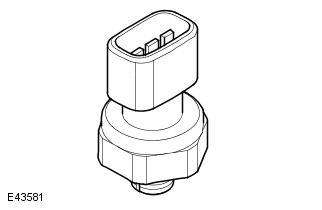
The refrigerant pressure sensor provides the ECM with a pressure input from the high pressure side of the refrigerant system. The pressure sensor is located in the refrigerant line between the condenser and the thermostatic expansion valve.
The ECM supplies a 5 V reference feed to the pressure sensor and receives a return signal voltage, between 0 V and 5 V, related to system pressure. The ECM uses the signal from the sensor to protect the refrigerant system from extremes of pressure.
If the pressure within the refrigerant system exceeds the minimum or maximum pressure limits, the ECM will disable the A/C compressor.
The ECM constantly sends a refrigerant system pressure signal to the ATC module. The signal is transmitted from the ECM to the CJB over the high speed CJB bus. The CJB acts as a gateway and provides the pressure signal to the ATC module over the medium speed CAN bus.
If the pressure within the refrigerant system rises above its maximum pressure limit, the ATC module will increase the amount of re-circulated air entering the cabin. This helps lower the pressure within the refrigerant system and thus helps to avoid having to disable the A/C compressor.
EVAPORATOR TEMPERATURE SENSOR
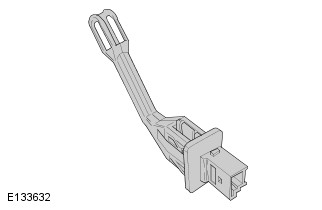
The evaporator temperature sensor is a NTC thermistor. The sensor is mounted on the LH side of the heater casing, and measures the temperature of cooled air once it has traveled over the evaporator. The sensor receives a 5 V reference feed from the ATC module. By monitoring the returned voltage, the ATC module can calculate the resistance of the sensor and hence evaporator temperature.
CABIN TEMPERATURE SENSOR
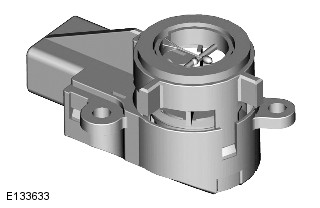
The cabin temperature sensor comprises a NTC thermistor and a motor. The sensor is mounted behind a grill on the drivers side of the instrument panel, adjacent the steering column.
The motor is provided an electrical feed from the ATC module and draws cabin air in through the grill and over the thermistor. The thermistor receives a 5 V reference feed from the ATC module. By monitoring the returned voltage, the ATC module can calculate air temperature within the cabin.
CABIN HUMIDITY SENSOR
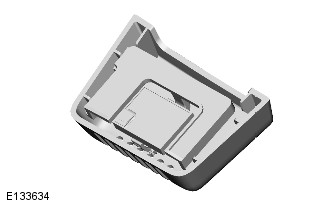
The cabin humidity sensor is located within the interior mirror and comprises 3 individual elements:
- A humidity sensor
- An air temperature sensor
- A windshield glass temperature sensor.
NOTE: The cabin humidity sensor is an optional fit only.
The readings from these 3 sensors combine to reduce the risk of misting on the windshield.
The humidity sensor element is contained behind a nylon mesh cover. The sensor comprises an element made up of film capacitors on different substrates. The dielectric is a polymer which absorbs or releases water proportional to the humidity of the air being drawn through the sensor. This causes a change in the capacitance of the sensor.
Humidity within the cabin is controlled by raising or lowering the temperature of the evaporator. An increase in evaporator temperature increases the moisture content of the air in the cabin. Lowering the evaporator temperature reduces the moisture content of the air in the cabin.
The capacitance of the sensor, together with both temperature values, is provided as LIN bus messages to the ATC module. The ATC module uses these signals to calculate the dew point of the air at the windshield. When the temperature of the windshield glass reaches or falls below this value, misting is likely to occur. In this instance, the ATC module will:
- raise the temperature of the air leaving the heater assembly
- adjust the position of the windshield distribution (defrost) stepper motor
- adjust the position of the air intake stepper motor
- the power windshield heater elements.
AMBIENT AIR TEMPERATURE SENSOR
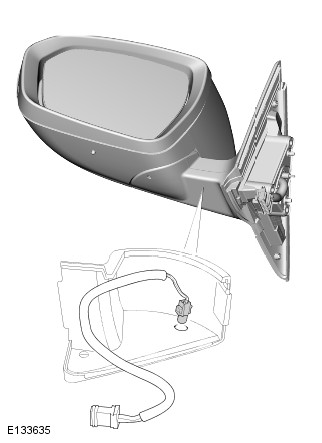
The ambient air temperature sensor is a NTC thermistor, and is mounted in the LH door mirror. The sensor receives a 5 V reference feed from the ECM. By monitoring the returned voltage, the ECM can calculate the resistance of the sensor and hence ambient air temperature. The ECM transmits an ambient air temperature value over the high speed CAN bus. This value is relayed to the ATC module by the CJB over the medium speed CAN bus.
SUNLOAD SENSOR
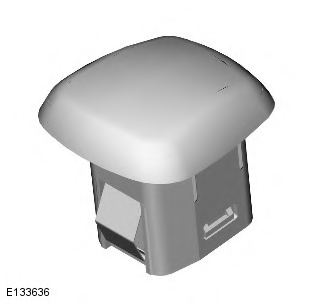
The sunload sensor is mounted in the center of the instrument panel upper surface. The sensor contains a photoelectric cell, which provides the CJB with an input of light intensity equating to the solar heating effect on the cabin.
The solar heating value is transmitted from the CJB to the ATC module over the medium speed CAN bus. The ATC module compensates for the solar heating effect by adjusting blower speed, air output temperature and air distribution to maintain the required cabin temperature.
POLLUTION SENSOR
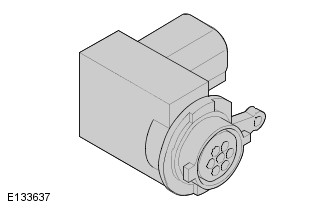
The pollution sensor allows the ATC module to monitor intake air for the level of carbon monoxide (CO) and oxides of nitrogen (NOx). The sensor is mounted on the passenger side of the heater casing.
NOTE: The pollution sensor is an optional fit on vehicles with a dual zone, automatic climate control system.
The pollution sensor is provided an ignition controlled feed from the BJB and provides one of the following 4 signals to the ATC module based on ambient air quality:
- Static or reduced pollution levels
- Small increase in pollution levels
- Medium increase in pollution levels
- Rapid or large increase in pollution levels.
Based on the signal from the pollution sensor, the ATC module is able to control the intake air source to reduce the amount of contaminants entering the cabin. This function is fully automatic, but can be overridden by manual selection of the air intake source using the fresh/re-circulated air switch on the control panel.

